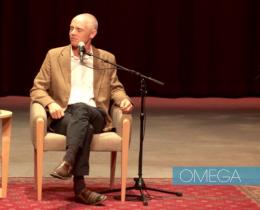Omega: How do you define self-compassion?
Michelle: The easiest, most simple definition of self-compassion is treating ourselves with the same kindness as we would treat a dear friend.
Omega: What is the relationship between mindfulness and self-compassion?
Michelle: There is no self-compassion without mindfulness, and there is no mindfulness without self-compassion (or compassion in general). They need each other for their full expression.
Mindfulness is a kind of balanced awareness—we're open to things as they are, with acceptance and nonjudgment. But when it's incomplete we can open to things as they are and not see the bigger picture of the pain in the world. When we understand and open to that pain, our own and others’, the only thing that makes sense is compassion. Compassion means we use our clear seeing in the service of the alleviation of suffering.
The same with self-compassion. The full expression of it rests on our clear seeing, our clear understanding of things as they are. This clear seeing arises out of mindfulness. When that’s incomplete, it’s possible to have a soft, fluffy kindness that isn’t really true compassion. It can feel a little like Stuart Smalley with his daily affirmations—a little phony because we haven’t fully opened to the reality of the painful situation we’re in. True compassion can only arise in response to the pain of the world. Self-compassion gives us the emotional resources and resilience that allows us to open to things as they are.
Omega: How can self-compassion help us change a habit? How is it different from willpower?
Michelle: Self-compassion meets us where we are and encourages us in the right direction rather than telling us we’re wrong or bad or that we should be somewhere else. If we’re chastised as we’re trying to reach our goals, then we’ll be unhappy and want to stop. Self-compassion has us open to the pain of the situation, then roots us in our deepest values by asking, “What do I really need here?” It uses that as the motivator.
Self-compassion will offer an encouraging voice to support you. It’s like a supportive teacher or coach who says, “I know it is important to you to get where you want to go, so how can I help you? Maybe we need to get a tutor or add in some form of exercise?” Maybe it is some encouraging words, like, “I know it’s hard to resist, but you can do it and you’ll be happier for it.” If someone who cares for us supports us, imperfect as we are in the moment, we can be happy where we are, even as we work to change things.
Willpower doesn’t necessarily rest on a foundation of accepting ourselves as we are. It sometimes rests on a foundation of discarding who we are in hopes of becoming something better. And the methodology it uses can be harsh and critical.
On the other hand, there is a power in willpower. Literally, its right in the name. That power, when combined with a deep understanding of our needs and care for ourselves, can be used in the service of self-compassion. Compassion isn’t always soft and fluffy. There is a strength in compassion, too.
Omega: Compassion has the reputation of being kind of soft and powerless. What do you say to that?
Michelle: There’s a common fear that compassion is weak, but it’s actually quite strong. If your child runs into the middle of the street and there's a car coming, you might be pretty harsh in your words or your tone, or you might yank them by the arm to pull them out of the way. This is how compassion can be fierce. It may not look compassionate on the surface, but the underlying intention or motivation is one of preventing or alleviating harm. So we don't want to get too hung up on this warmth factor. More often than not it’s warm, but sometimes it’s not—it’s harsh but still in the service of compassion.
Omega: It’s widely believed that kindness can make people self-indulgent or lazy. Do you find that to be true?
Michelle: Self-kindness is one part of self-compassion, and self-criticism is often portrayed as its opposite. But I think self-indulgence can be on the other end of the spectrum, too. Self-indulgence can look warm and kind—like letting your kids eat ice cream all day because they want to and you want to be kind to them—but it’s harmful, so ultimately it’s not kind or compassionate.
This is where the mindfulness piece comes in—the application of wisdom from mindfulness helps us know what is truly compassionate and what is not.
Omega: How do we integrate external information—like all the conflicting guidelines about what to eat and what not to eat—with our internal wisdom?
Michelle: The quintessential question in mindful self-compassion is, "What do I need right now, given what’s happening?” The question is not, “What do I want?” nor is it, “What would feel good in this moment?” It’s more an inquiry about what is the most skillful offering I could give to myself right now.
If I don’t know what I truly need right now—this can be the frustration with things like changing nutritional guidelines—then you eat something and notice what happens to you. You start to sort out the right strategy for you. This is true for other things too—we look inside and ask ourselves, “What actually happens when I try this or that? Does it feel good in the moment but not the long run? What would really help?”
Omega: Is it possible that when someone begins practicing self-compassion and opens up to their pain they might feel worse at first?
Michelle: It’s not uncommon for this to happen. We've developed our coping mechanisms and strategies that prevent us from noticing that we're in pain. Maybe we are halfway through a bag of potato chips before we even realize we're eating. But we come to and realize we felt uncomfortable and wanted to numb out. This coping strategy was keeping us from feeling that. When we start to feel those feelings, we can feel a little bit worse at the beginning of the process.
There is also a phenomenon we call backdraft. When firefighters go into a building and there is a closed door, they feel to door to see if it’s hot. If it is, they know there’s a fire in the room. That fire has likely consumed most of the oxygen in the room, and if they open the door the fire would be fueled by the incoming oxygen and dramatically erupt into the hallway.
As humans we have something similar happen. When painful things happen to us in life and we don’t have the resources to manage them in that moment, we metaphorically scoop them up and stuff them in the hall closet. Then we come to a self-compassion class and we open the door of the heart to let compassion in, and all this pain we’ve been carrying comes tumbling out like a fire would in backdraft. Compassion opens the door to the pain we’ve been carrying.
It can feel painful or like there’s something wrong with me, the program, the teacher, or even with compassion. But it’s actually a sign that there’s something right happening. Compassion doesn’t ever create pain, but it opens a safe space in which the pain we have been storing can emerge. We teach people ways to be with this if and when it happens.
Although it might sound scary, it is the path toward healing. Christopher Germer like to say that we go from “Ka-Boom” to “Ka-Bloom.”
Omega: How do we avoid compassion fatigue?
Michelle: A lot of people use this phrase, but compassion is not fatiguing. They may be confusing it with empathy, which can be fatiguing.
Tania Singer is a leading researcher in empathy and compassion and I love the model she has created to describe the difference. The first level is emotion contagion—we catch each other’s feelings like we catch the flu. If we’re around people who are laughing and having a good time, our mood lifts. If we’re around someone who is sad or angry, we begin to feel that way, too.
A step up from emotional contagion, Singer says, is empathy. Empathy is emotion contagion plus the sense of a separate self. It’s when I realize I’m feeling something but that what I’m feeling is yours, not mine. I’m feeling your anger or sadness or happiness.
One more step up from that is compassion, which is empathy plus love. Love—truly wishing well for another, is a good feeling. It’s what allows us to take steps wherever possible to end another’s suffering. We feel the pain of the other, but love provides the buffer within which we hold the pain so that our overall experience is one of love rather than distress.



